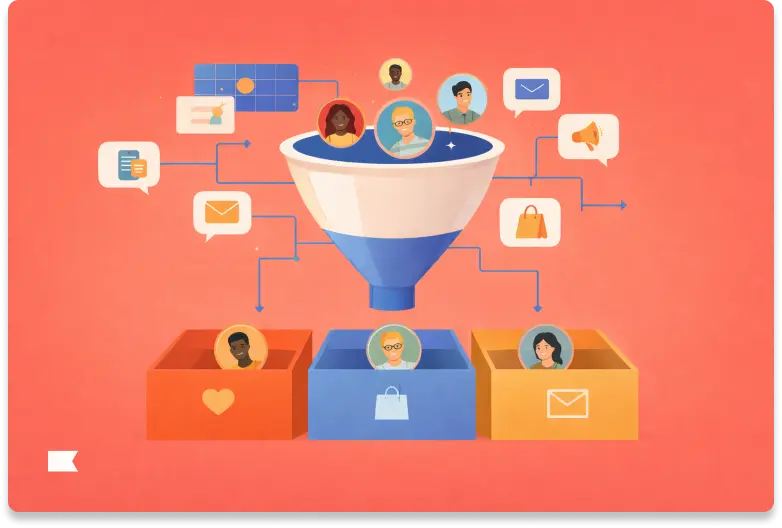Klaviyo’s 2025 online shopping report: how to meet the consumer where they scroll
Consumer shopping behaviors are shifting faster than marketing teams can test. Budgets are tightening. And the pressure to deliver ROI across every channel is intensifying. While strategies have to evolve, time and resources remain finite—especially for lean teams balancing brand, performance, and retention goals.
To help, Klaviyo is putting data in the hands of marketers so they can make better, more strategic decisions.
We surveyed 2,000 consumers across the US, the UK, Australia, and New Zealand to uncover how people are actually shopping today: how they browse, when they buy, and what makes them engage. Because while personalization and omnichannel coordination have become non-negotiables, not every team has the data—or the hours—to map the modern journey themselves.
This research is designed to close that gap. It translates emerging behavior into actionable insights: where discovery happens, which channels drive trust, and how generational tone preferences can make or break engagement. These aren’t trends. They’re behavioral mandates. And they should change the way marketers operate.
Klaviyo’s new omnichannel capabilities go beyond simply connecting channels—they bring the entire customer journey into focus. With real-time data, AI-driven automation, and a clear view of performance, marketers can take action where it matters most.
Consumers aren’t just channel-hopping—they’re orchestrating their journey
Today’s shopping journey doesn’t happen in one place—it flows across channels. 77% of global consumers shop across 3–4 channels, and more than 20% use 5 or more, intentionally.
Whether they’re discovering products on social, comparing options on a branded app, or checking out in-store, consumers are curating their own omnichannel experiences.
For consumers, this seamless coordination means they can engage with brands on their own terms—wherever and whenever it’s most convenient for them.
And for brands, a disconnected strategy isn’t just inefficient—it’s a risk. Consistency, coordination, and timing are no longer nice-to-haves. They’re expectations. To keep up, marketers need more than channel coverage—they need channel connection.
That’s where Klaviyo’s omnichannel campaign builder comes in: enabling teams to plan multi-audience, multi-message campaigns across email, SMS/RCS, push, and WhatsApp—in one place.
Aligning channel strategy to consumer behavior
In categories like beauty and fashion, 1 in 5 consumers turn to social for product discovery (23% and 19%, respectively). That doesn’t mean social isn’t valuable. It means its role is shifting—and marketers need to shift with it. If your social strategy is built for conversion, you’re likely measuring the wrong outcome.
The better play? Use social to prime demand, then follow up where consumers are more likely to act: email, SMS, or even WhatsApp.
And while every channel has a role, it doesn’t play the same for every audience. Gen Z prefers branded apps (12%) and SMS (14%). Boomers lean toward email (44%) and in-store (27%). These preferences aren’t random—they’re patterns.
That’s where Klaviyo’s AI-powered channel affinity comes in: giving marketers real-time intelligence about not just where people are active, but what they actually engage with. So you can prioritize the right channels—and use them with purpose.
Email still leads—but messaging apps are closing in
Email remains the most trusted channel for brand communication. Consumers prefer to stay in touch with their favorite brands via email across categories like fashion (38%), electronics (38%), travel (40%), and beauty (40%). But trust doesn’t guarantee performance.
Our research shows email engagement peaks in the morning (37%), while in-app and social interactions rise in the evening (26% and 28%, respectively)—highlighting how critical timing and coordination are in omnichannel strategies.
At the same time, messaging apps like WhatsApp are gaining serious traction. That’s especially true in markets like the UK, where 8% of consumers engage with brands via WhatsApp—more than twice the rate seen in the US or Australia. These channels aren’t emerging—they’re established, and they reflect how consumer preferences vary not just by generation, but by region and context.
For marketers, the takeaway is clear: channels aren’t interchangeable. Klaviyo recently launched WhatsApp and RCS, unlocking two of the world’s most powerful mobile messaging channels for brands. Brands can now send interactive, branded messages—like product carousels, back-in-stock alerts, and limited-time offers—through tap-to-reply conversations that feel personal, real-time, and optimized for conversion.
Email, messaging, and app-based communication each have their moment—and successful strategies match message, timing, and medium to the customer’s expectations.
Gen Z wants brands that are human, not corporate
Younger generations have rewritten the rules of engagement. Nearly 30% of Gen Z consumers—more than any other generation—are more likely than average to engage with brands that use puns, emojis, or playful language in SMS.
They also game the system: 67% of Gen Z and 63% of millennials say they intentionally ignore messages in one channel hoping for a better offer in another.
The implications are serious: consistency across channels is no longer optional. The same customer is watching how you show up on email, text, and social—often at the same time.
Loyalty is earned at the edges
Consumers are inundated, skeptical, and increasingly willing to walk away. But they’re also open—to convenience, personality, and personalization. That’s why some of the strongest signals we saw weren’t just about where people shop, but how they want brands to behave.
- 61% of consumers actively subscribe to communications from 3–8 brands, and 9% subscribe to more than 15.
- Women are 2.5x more likely than men to subscribe to over 15 brands, signaling a higher appetite for personalized content and promotions.
- Nearly 2x as many consumers say they’d prefer AI to remember their preferences than share them with a store associate.
That tells us that loyalty doesn’t come from aggressive discounting or generic outreach—it comes from relevance, consistency, and respect.
What it all means for marketers
We’re entering a new age of consumer connection. Not just omnichannel, but omni-intent. Customers move seamlessly from social scroll to cart abandon to inbox check to store visit. Brands that win will be the ones who move with them—coordinating tone, timing, and tactics across every touchpoint.
At Klaviyo, we believe the future belongs to marketers who think like systems architects and storytellers at once.
Great marketing isn’t just multichannel. It’s synchronized, strategic, and deeply human.

Related content

Discover how audience filters let you personalize every message in an omnichannel campaign using real-time data, behavior, and channel preferences.

Klaviyo welcomes Chano Fernández as Co-CEO to help accelerate global growth and lead the next era of AI-powered customer experiences.

Discover how cross-channel marketing and the rise of SMS shaped BFCM 2025. Learn why email + text orchestration drove record engagement, efficiency, and revenue.